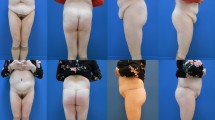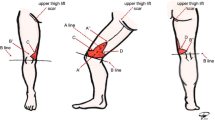Abstract
Background
With the increasing incidence of obesity in Western societies, an increasing number of patients undergo bariatric surgery that leads to functional and aesthetic sequelae related to a rapid and massive weight loss, namely, skin and fat excess. The goal of surgical management after massive weight loss is to optimize the functional results obtained from bariatric surgery or diet by removal of the redundant skin folds. The authors report their experience with medial thighplasty after massive weight loss and identify factors predictive of postoperative complications.
Methods
This retrospective study investigated 53 patients who underwent surgery for medial thighplasty after massive weight loss. Data were collected through chart review and submitted to statistical analysis.
Results
The average weight loss before thighplasty was 43.5 ± 14.9 kg, and 39.6 % of the patients experienced at least one complication. The complications were seroma (9.4 %), wound dehiscence (20.8 %), scar migration (17 %), wound infection (5.7 %), and partial skin necrosis (1.9 %). The body mass index (BMI) before massive weight loss and the BMI before medial thighplasty were found to be risk factors for the development of a postoperative complication.
Conclusion
Few guidelines exist for the optimization of care and safety in this complex patient population. The information from this retrospective study complements the current data from the literature and can help surgeons select patients eligible for medial thighplasty. This report shows that the BMI before medial thighplasty should be taken into consideration for patients willing to undergo a body-contouring procedure.
Level of Evidence IV
This journal requires that authors assign a level of evidence to each article. For a full description of these Evidence-Based Medicine ratings, please refer to the Table of Contents or the online Instructions to Authors www.springer.com/00266.



Similar content being viewed by others
References
Gallagher EJ, Leroith D, Karnieli E (2010) Insulin resistance in obesity as the underlying cause for the metabolic syndrome. Mt Sinai J Med NY 77:511–523
Lavie CJ, Milani RV, Ventura HO (2009) Obesity and cardiovascular disease: Risk factor, paradox, and impact of weight loss. J Am Coll Cardiol 53:1925–1932
Van Gaal LF, Mertens IL, De Block CE (2006) Mechanisms linking obesity with cardiovascular disease. Nature 444:875–880
Montague CT, O’Rahilly S (2000) The perils of portliness: causes and consequences of visceral adiposity. Diabetes 49:883–888
Bochukova EG, Huang N, Keogh J, Henning E, Purmann C, Blaszczyk K et al (2010) Large, rare chromosomal deletions associated with severe early-onset obesity. Nature 463:666–670
Clement K, Vaisse C, Lahlou N et al (1998) A mutation in the human leptin receptor gene causes obesity and pituitary dysfunction. Nature 392:398–401
Emilsson V, Thorleifsson G, Zhang B et al (2008) Genetics of gene expression and its effect on disease. Nature 452:423–428
Menzaghi C, Ercolino T, Di Paola R et al (2002) A haplotype at the adiponectin locus is associated with obesity and other features of the insulin resistance syndrome. Diabetes 51:2306–2312
Strawford A, Antelo F, Christiansen M, Hellerstein MK (2004) Adipose tissue triglyceride turnover, de novo lipogenesis, and cell proliferation in humans measured with 2H2O. Am J Physiol Endocrinol Metab 286:E577–E588
National Institutes of Health (1992) Gastrointestinal surgery for severe obesity: National Institutes of Health Consensus Development Conference Statement. Am J Clin Nutr 55(Suppl 2):615S–619S
Lewis JR (1957) The thigh-lift. J Int Coll Surg 27:330–334
Lewis JR (1966) Correction of ptosis of the thighs: the thigh-lift. Plast Reconstr Surg 37:494–498
Le Louarn C, Pascal JF (2004) Internal faces lifting legs complications. Ann Chir Plast Esthet 49:610–613
Schultz RC, Feinberg LA (1979) Medial thigh lift. Ann Plast Surg 2:404–410
Vilain R, Dardour JC (1986) Aesthetic surgery of the medial thigh. Ann Plast Surg 17:176–183
Le Louarn C, Pascal JF (2004) The concentric medial thigh lift. Aesthetic Plast Surg 28:20–23
Lockwood TE (1988) Fascial anchoring technique in medial thigh lifts. Plast Reconstr Surg 82:299–304
Mathes DW, Kenkel JM (2008) Current concepts in medial thighplasty. Clin Plast Surg 35:151–163
Labardi L, Gentile P, Gigliotti S et al (2012) Medial thighplasty: horizontal and vertical procedures after massive weight loss. J Cutan Aesth Surg 5:20–25
Kenkel JM, Eaves FF (2008) Medial thigh lift. Plast Reconstr Surg 122:621–622
Adams TD, Gress RE, Smith SC et al (2007) Long-term mortality after gastric bypass surgery. N Engl J Med 357:753–761
Buchwald H, Estok R, Fahrbach K et al (2009) Weight and type 2 diabetes after bariatric surgery: systematic review and meta-analysis. Am J Med 122:248–256
Rubino F, Gagner M, Gentileschi P et al (2004) The early effect of the Roux-en-Y gastric bypass on hormones involved in body weight regulation and glucose metabolism. Ann Surg 240:236–242
Tindle HA, Omalu B, Courcoulas A et al (2010) Risk of suicide after long-term follow-up from bariatric surgery. Am J Med 123:1036–1042
Arthurs ZM, Cuadrado D, Sohn V et al (2007) Postbariatric panniculectomy: pre-panniculectomy body mass index impacts the complication profile. Am J Surg 193:567–570 discussion 70
Colwell AS, Borud LJ (2008) Optimization of patient safety in postbariatric body contouring: a current review. Aesth Surg J 28:437–442
van der Beek ES, van der Molen AM, van Ramshorst B (2011) Complications after body-contouring surgery in postbariatric patients: the importance of a stable weight close to normal. Obes Facts 4:61–66
Duff CG, Aslam S, Griffiths RW (2003) Fleur-de-Lys abdominoplasty: a consecutive case series. Br J Plast Surg 56:557–566
Shrivastava P, Aggarwal A, Khazanchi RK (2008) Body-contouring surgery in a massive weight loss patient: an overview. Ind J Plast Surg 41:S114–S129
Gusenoff JA, Coon BA, Rubin JP (2008) Brachioplasty and concomitant procedures after massive weight loss: a statistical analysis from a prospective registry. Plast Reconstr Surg 122:595–603
Kolker AR, Xipoleas GD (2011) The circumferential thigh-lift and vertical extension circumferential thigh-lift: maximizing aesthetics and safety in lower extremity contouring. Ann Plast Surg 66:452–456
Kolker AR, Lampert JA (2009) Maximizing aesthetics and safety in circumferential-incision lower body lift with selective undermining and liposuction. Ann Plast Surg 62:544–548
Author information
Authors and Affiliations
Corresponding author
Rights and permissions
About this article
Cite this article
Bertheuil, N., Thienot, S., Huguier, V. et al. Medial Thighplasty After Massive Weight Loss: Are There Any Risk Factors for Postoperative Complications?. Aesth Plast Surg 38, 63–68 (2014). https://doi.org/10.1007/s00266-013-0245-7
Received:
Accepted:
Published:
Issue Date:
DOI: https://doi.org/10.1007/s00266-013-0245-7




